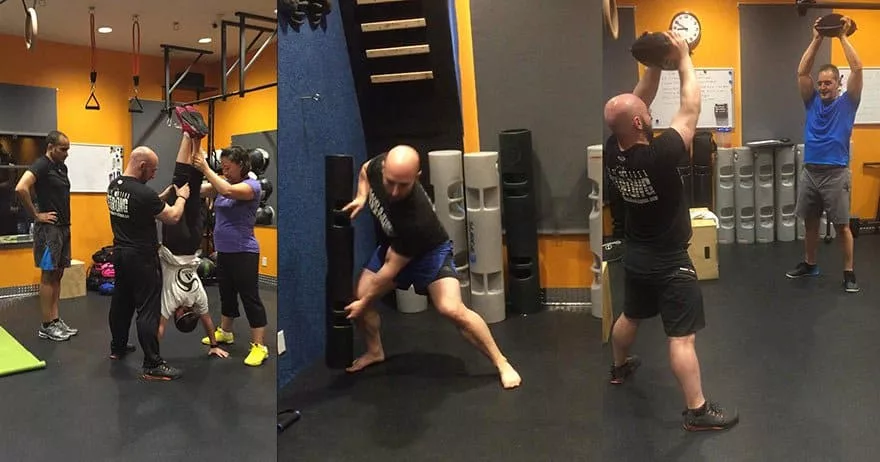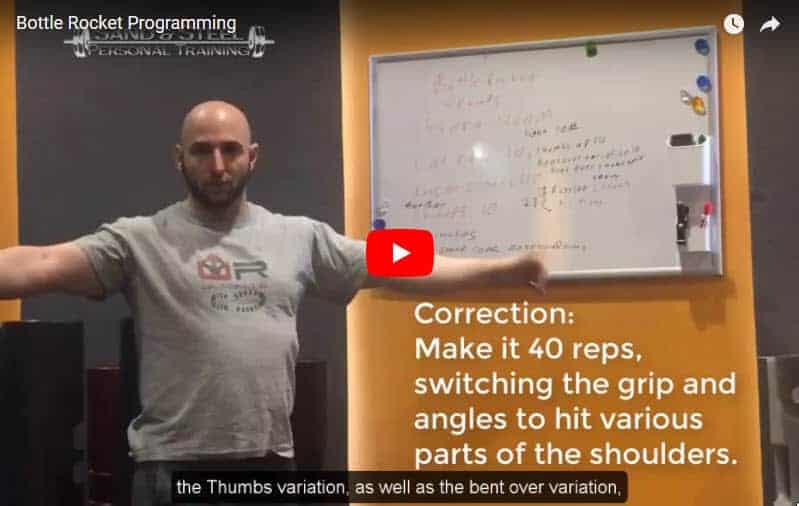Is your workout routine really working for you? Are you conflating getting sweaty with getting results (e.g. an exercise routine vs training program)? Here are some tips to help you transition from simply working out, to building yourself a real workout program.
More Personal Trainer Alexandria Resources
Exercise is:
Physical activity performed for the effect it produces today — right now. Each workout is performed for the purpose of producing a stress that satisfies the immediate needs of the exercise, burning some calories, getting hot, sweaty, and out of breath …. Exercise is physical activity done for its own sake, either during the workout or immediately after it’s through. Exercise may well involve doing exactly the same thing everything you do it, as as it accomplishes the task of making you feel like you want to feel today.
Marc Ripptoe, Practical Programming for Strength
Training is:
Physical activity performed for the purpose of satisfying a long-term performance goal. The process must generate a definable result which requires planning. Series of workouts must be structured so that improvements in strength are balanced to prevent joint injuries, and exercise resistance and complexity must be purposefully scaled to achieve the desired result. Training gets more complicated when a coach is tasked with combining training for various sports or activities such as running or cycling since proper recovery periods and periodization must be considered. More training hours does not always improve results. Careful focus
Paul Roberts on Programming
What’s Wrong with Your Gym?
That depends … is your gym 40% cardio machines? Cardio machines are great for commercial gyms because they pack the highest amount of people per square inch into them. Plus, who doesn’t like doing repetitive motions (e.g. ski machine) while watching reruns of Cheers? I mean that’s training right?
Or maybe we need the other 40% of the floor space dedicated to single use machines? It super critical for you to hire a “personal trainer,” to help you … who else is going to count your reps. Oh wait, technogym equipment already does that for you. The truth is globo gyms need these machines, because those gym doesn’t want you to learn how to lift real weights (kettles, barbells, etc.) If you do, you won’t need to pay for their gym memberships! Plus these machine more compactly fit people to maximize revenue per square foot. It also allows them to hire unqualified trainers, because the machines help keep you from hurting yourself. At the same time, they also prevent you from building any real strength.
The remainder 20% of the floor space? Well, we’ll need 3-4 bench press stations, since we can’t use “machines” to do a simple press. (I’m not sure why that is — especially since benchpress causes more deaths per year than any other exercise — guess people like doing bench on Mondays.) Plus we should have a decline bench, eventhough the research is conclusive the decline bench press is a waste of time. And maybe 2 squat racks tucked away in the corner. These are dangerous machines after all … that require technique and a lot of floor space (less profitable.)
The DVD / CrossFit/ Orange Theory Program
Whether your poison is P90X, CrossFit, or Orange Theory, your program doesn’t work as well as it could, because it’s not a program. Since difficulty and “sweatiness” is so easily confused with results, the fitness industry has the public in it’s clutches. By frequently shifting the workouts, they are always difficult and sweaty, but without a program, you don’t actually improve.
Programming requires individual customization to the individual. Everyone progresses at different speeds in different areas. There is no way to do this in a group setting following a predetermined program without substantial modifications. Programming these workouts requires a coach who can assess movement issues, imbalances, and injury-risk. Coaches like that are expensive to hire, and time consuming to train.
When injuries from doing these prepackages programs occur (and they do occur with alarming frequency), the public generally takes responsibility for the injury. “It was my fault I got injured doing Insanity, I guess I wasn’t doing it right.” And in truth, probably not. Or perhaps that person shouldn’t have been doing plyo-tuck jumps in the first place. More to the point, maybe the company that creates Insanity should determine which program is appropriate.
With a properly customized training program, your risk of injury is very minimal. Such a program has to be:
- Scaled to your mobility (range of motion + flexibility) and stability (the ability to control that motion),
- Periodized so that difficulty increases over the correct period of time,
- Analyzed to determine whether any muscle imbalances have developed that need to be corrected through accessory movements and “corrective exercise.”
If those 3 steps are not performed, your exercise routine:
- Isn’t as efficient as it could be,
- Exposes you to more risk than it needs to, and
- Doesn’t address the major limitations to your performance.
Programming Missteps
So you obviously subscribe to Sand & Steel’s Blog, you’ve read about the importance of a customized program (maybe downloaded one or two of our workouts), and you are going to do one-rep maxes on all your key lifts (squat, clean, deadlift, bench, overhead press, etc.) to build a strength training program. But before you do so, consider the level of your training in these moves. If a novice lifter measures his one rep squat to be 150 pounds … does that really mean anything when his or her form so inefficient that 50% gains can be had simply by improving the technique? Or worse, yet, faced with peer pressure or simply to desire to score higher, our brand new “committed” exerciser gets injured performing the movement on day 1.
Upgrade Your Program
I’ve personally written about 1000 workouts, and it takes me 3-4 rounds (e.g. # of times the workout has been completed) through the workout to optimize it. But, once you do 3-4 rounds of the workout, you should start thinking about variations of that program, because of imbalances and diminishing returns (e.g. swapping a conventional deadlift for a sumo deadlift.) So, the first time going through a program, you are more or less crafting it for the next time you do it. In general, most people do three programs, rotating through each one on a bi-monthly basis.
There is an important point here, it takes me (a coach with over 10,000 coaching hours under my belt), 3-4 runs through the workout to perfect it. How many times do you upgrade your own workout?
Driving Performance: Don’t wait until it “gets easy”
Why do clients I train get better results than other personal trainers? I DRIVE INTENSITY. Don’t wait until your 4-5 sets of 8-12 starts to feel easy before increasing the weight. You need a competent coach to plan increases for you, watch your technique, and drive performance. It’s no secret, having someone with you to guilt you, motivate you, support you, etc. helps tremendously. In many cases, it’s the key difference that generates results. The body has to be pushed hard to improve.
People get this concept wrong because of the Novice Effect (a term coined by Mark Ripptoe.) The premise is simple, the Novice lifter will see improvement regardless of his or her method. This can occurs for the first 4-8 weeks. Afterward that period lapses, improvements rapidly decline, and a plateau is reached. There can be many reasons for the plateau, one of which may be intensity.
Final Thoughts About Doing Your Own Research
Details Matter. Most of the studies you read (even the ones done in Research journals) have numerous problems with the method in terms of assumptions. Let’s say the study is on the deadlift. How much training did these people receive? Who trained them? What are participants relative limb lengths (Do you know why that even matters)? How was max force calculated (e.g. try your best to lift it?) Where was the bar positioned? Were they barefoot or wearing running shoes? How many people were in the study? How many got injured? Did they get injured because of the study?
When bloggers write articles… there is overwhelming desire to simplify things, because people don’t read the whole article. These simplifications, while convenient, often hide the truth. And the truth is complicated.
Hiring a Coach
There are some people in this world that build their own decks, cater their own parties, and even defend themselves in court. And then there are the people who accept that they can’t be experts at everything, and they get professional help, because it makes a difference. Even if it’s just once a week, a professional lifting coach can double or triple the improvement you get on your own. Isn’t time and your body worth that?

